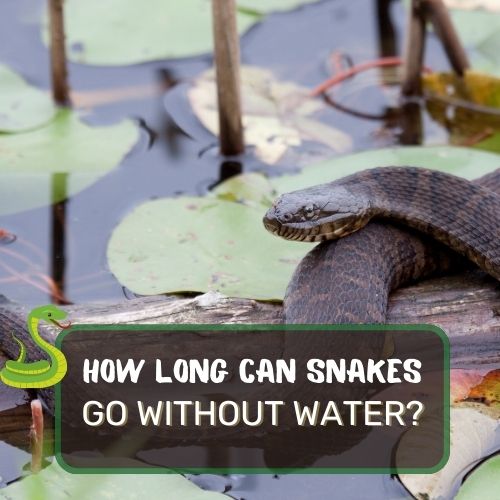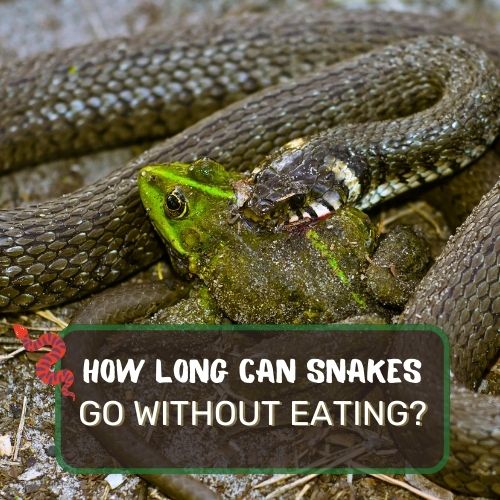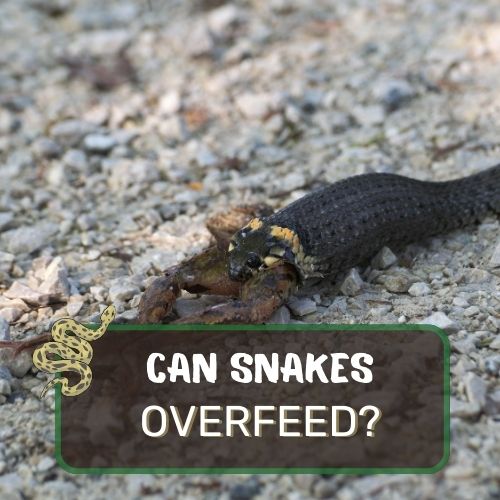Dive into the enigmatic world of snakes as we explore whether it is safe for snakes to eat while they shed. This article sheds light (pun intended!) on the intricate dance between a snake’s shedding process and its feeding habits.
While some snakes can eat during shedding, many prefer not to. The shedding process, known as ecdysis, makes them vulnerable, with impaired vision and heightened sensitivity. In the wild, this can make hunting risky. In captivity, some snakes might eat, but it’s essential to observe their behavior.
We’ll journey through the wild terrains and the confines of captivity, examining the risks and nuances of feeding during this vulnerable phase. From understanding the shedding stages to offering feeding tips, we’ve covered all bases.
Join us on this captivating expedition into the life of these mesmerizing reptiles.

Table of Contents
The Dangers of Feeding a Snake During Shedding
When you think of a snake shedding its skin, you might imagine it as a time of renewal and growth. And you’d be right! But have you ever wondered about the snake’s behavior during this crucial period, especially when it comes to feeding?
The Importance of Shedding in a Snake’s Life Cycle
Shedding, scientifically known as ecdysis, is an essential part of a snake’s life cycle. It’s not just about getting a new outfit; it’s about growth, health, and survival.
As snakes grow, their old skin becomes tight, much like how our clothes might feel snug after a hearty meal. This old skin needs to be replaced to accommodate their growing bodies.
Moreover, shedding helps in removing parasites that might have latched onto their old skin. It’s like a fresh start, a rebirth if you will.
But here’s the catch: while this process is vital for the snake, it’s also a period of vulnerability. Their vision is impaired due to the old skin covering their eyes, and their entire body is in a state of transition.
The Natural Behavior of Snakes During Shedding in the Wild
Imagine you’re wearing a pair of foggy glasses. Your vision is blurred, and you’re more cautious about your surroundings.
This is somewhat how a snake feels when it’s shedding. In the wild, where survival is the name of the game, snakes prefer to lay low during this period. It’s not the best time to go hunting or be adventurous.
In their natural habitat, snakes are both predators and prey. When they’re shedding, their compromised vision and the physical process of removing the old skin make them more susceptible to threats.
This is why, in the wild, snakes often retreat to safe hiding spots, avoiding any potential confrontations.
Why Eating During Shedding Can be Risky
Now, let’s talk about the main event: feeding. With their vision compromised and their senses not at 100%, hunting becomes a risky endeavor for snakes during shedding. Remember, in the wild, a snake’s prey isn’t just a passive meal.
Rodents, for instance, can be quite feisty. They have sharp claws and teeth, and if a snake, with its dulled senses, makes a wrong move, it could end up injured.
Imagine a snake trying to catch a rat, but the rat, sensing the snake’s vulnerability, fights back. It’s not a pretty picture.
Moreover, the act of eating and digesting food requires energy. During shedding, a snake’s body is already expending a lot of energy. Adding the process of digestion to this can be taxing.
In captivity, the scenario might be a bit different. With no natural predators and food being served on a platter (or a terrarium), one might think it’s safe for snakes to eat during shedding.
However, many snakes still exhibit their natural instincts and prefer not to eat during this period.

Shedding and Feeding in Captivity vs The Wild
Let’s take a closer look at how the world of captive snakes contrasts with their wild counterparts when it comes to shedding and feeding.
Differences in Feeding Habits Between Wild and Captive Snakes
In the wild, a snake’s life revolves around the hunt. The thrill of the chase, the strategy, the final strike—it’s all a part of their natural behavior.
Wild snakes have honed their hunting skills over generations, adapting to their environment and the challenges it presents. During shedding, as we’ve discussed, this hunt becomes riskier due to impaired vision and heightened vulnerability.
On the flip side, captive snakes lead a different life. They don’t need to hunt for their food; it’s provided to them. Whether it’s live prey or pre-killed, feeding time in captivity is a more controlled and predictable event.
This predictability can sometimes lead to changes in feeding behavior. For instance, some captive snakes might be more willing to eat during shedding because they’ve learned that their food poses no threat.
How Shedding Affects a Snake’s Hunting Abilities
Shedding is like a temporary handicap for snakes in the wild. Their usually sharp senses are dulled, making the hunt more challenging. The protective scale over their eyes, known as the brille, becomes cloudy during shedding, affecting their vision.
This cloudiness, combined with the physical act of shedding, makes them less agile and more prone to mistakes. In the wild, a single mistake during a hunt can be fatal.
The Reduced Risks of Feeding in Captivity
Captive environments offer a safety net. The usual dangers associated with hunting are minimized or eliminated. There are no rival predators, and the prey, especially if pre-killed, poses no threat.
This safety allows some snakes to feel comfortable enough to eat during shedding. However, it’s essential to note that while the external risks are reduced, the internal processes of the snake remain the same.
Their body is still undergoing the taxing process of shedding, and adding digestion to the mix can be strenuous.

Optimal Times to Feed a Snake During Shedding
Feeding a snake is not just about dropping food into its enclosure. It’s an art, a science, and a dance of understanding the snake’s behavior, especially during the shedding phase. So, when is the best time to offer food to a snake that’s shedding its skin?
Let’s unravel this mystery.
Observing the Shedding Process
The shedding process is a fascinating journey, and observing it can provide valuable insights into your snake’s well-being. It begins with the skin becoming dull and the eyes turning a milky blue or gray, indicating the start of the shedding cycle.
This is the snake’s “blue phase.” During this time, the snake’s vision is significantly impaired, making it a less than ideal time to introduce food.
Identifying the Stages of Shedding
Shedding isn’t a one-size-fits-all process; it occurs in stages. After the “blue phase,” the snake’s eyes will clear up, but the actual shedding is yet to begin. This is a preparatory phase where the old skin separates from the new one underneath.
It’s like the calm before the storm. The actual shedding starts when the snake rubs its head against rough surfaces, creating an opening to peel away the old skin. This process can last anywhere from a few hours to several days, depending on the snake’s size and species.
Best Moments to Offer Food
Now, let’s get to the heart of the matter. When should you offer food? After the “blue phase” and before the actual shedding begins is a potential window. The snake’s eyes have cleared, but it hasn’t started the physically demanding process of shedding.
However, it’s essential to tread with caution. Some snakes might still refuse food, and that’s okay. It’s always better to err on the side of caution.
Once the shedding is complete, and the snake has successfully discarded its old skin, it’s generally safe to resume the regular feeding schedule. The snake is back to its prime state, with clear vision and heightened senses, ready to enjoy its meal.

Tips on Feeding a Snake During Shedding
Feeding a snake during its shedding phase can be a bit like walking a tightrope. It requires a delicate balance of understanding and care. Here are some handy tips to ensure your slithery friend gets the nutrition it needs without any hiccups:
Choosing the Right Food
Always opt for food that your snake is familiar with. This isn’t the time to introduce a new type of prey. Familiarity can be comforting, and a recognized meal is more likely to be accepted.
Ensuring the Food is Safe and Appealing
If you’re feeding your snake frozen prey, ensure it’s thoroughly thawed and warmed to room temperature. A cold meal can be off-putting. Also, make sure the prey is fresh. Old or decomposed food can be harmful and is less likely to be eaten.
Precautions to Take to Avoid Stressing or Injuring the Snake
Always be gentle and avoid sudden movements. If using tongs to offer the food, approach the snake slowly and calmly. If the snake shows signs of stress or disinterest, it’s best to remove the food and try again later.
Remember, during shedding, the snake is more vulnerable, so it’s crucial to be extra cautious and patient.
Feeding a snake during shedding is all about understanding its needs and ensuring its comfort. With a bit of patience and these handy tips, you’ll be well-equipped to care for your snake during this transformative phase.

Conclusion
You’ve journeyed through the intricate world of snakes, uncovering the nuances of their shedding and feeding habits. While shedding, a snake’s vulnerability can influence its decision to eat, whether in the wild or captivity.
It’s crucial to understand and respect these natural behaviors, ensuring the well-being of these fascinating creatures. As you continue exploring the realm of reptiles, remember that observation and patience are key.
Every snake is unique, and with knowledge and care, you can foster a harmonious relationship with these mesmerizing beings. Keep learning and stay curious!
FAQ
Navigating the world of snakes, especially during their shedding phase, can be filled with questions. Here are some frequently asked questions to help shed some light (pun intended!) on this intriguing process.
What does a snake do when it’s shedding?
When a snake is shedding, it’s undergoing a process called ecdysis. This is where the snake replaces its old skin with a new one. Initially, the snake’s skin becomes dull, and its eyes might turn a cloudy blue or gray, known as the “blue phase.” During this period, the snake might become more reclusive, seeking shelter or hiding spots. As the shedding process progresses, the snake will rub its body against rough surfaces to help peel off the old skin.
Can you touch a snake while shedding?
It’s best to avoid handling a snake during its shedding phase. The snake is more vulnerable during this time, and touching or handling can cause stress or even damage the delicate new skin underneath. If you must move the snake, be gentle and quick, minimizing contact.
Do snakes want to eat after shedding?
After shedding, snakes often return to their regular behaviors, including feeding. Many snakes might have an increased appetite post-shedding since they might have refrained from eating during the shedding process. However, each snake is unique, so it’s essential to observe and understand your snake’s individual preferences and habits.




0 Comments